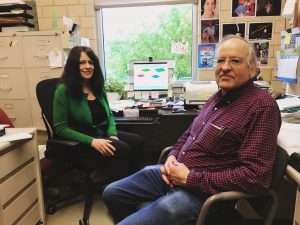
In many ways, the world is moving toward becoming more efficient and environmentally friendly. At Iowa State University, a team in the Microelectronics Research Center (MRC) and the Department of Electrical and Computer Engineering (ECpE) recently won a $1.43 million grant from the Department of Energy (DOE) for their project focusing on aiding the environment. The researchers plan to help by reducing the amount of electricity used for lighting in the world by almost half. Electricity and cost will be reduced with an advanced type of organic, safe lighting called OLEDs — Organic Light Emitting Diodes.
The team, Adjunct Professor and Senior Scientist Ruth Shinar (PI), Adjunct Professor and Senior Scientist Rana Biswas and Professor Joe Shinar, is specifically investigating fabrication methods for enhancing light extraction from OLEDs. Right now, only approximately 20 percent of the light generated in the OLED is extracted in the forward direction. The DOE hopes to increase that to 70 percent, a goal ECpE’s team may be able to help achieve. But this all may depend on the device design.
“We are trying to increase the light outcoupling, which will basically result in higher OLED efficiency,” Ruth Shinar said. “To do that, we are using flexible substrates — plastic substrates — with different features — different patterns. All the features of this substrate need to be very smooth.”
OLEDs are already successful in display technology, seen in TVs at Walmart or Best Buy, or in many smartphones. OLEDs are special kinds of light sources, because they are both organic (largely made of carbon-based materials), and the emitted light is diffuse, unlike the point source LED light.
“LED lights are pretty much point-light sources, whereas OLEDs are diffuse, i.e., emitted by a large area emitter. That difference can be seen on a smartphone,” Joe Shinar said. “The flashlight is probably an LED — it is extremely bright — but if you look at it, it is really a tiny point-light source. The rest of the display is an OLED display — it’s over a larger area and more diffused.”
Unlike common light sources usually seen in homes and offices, OLEDs are solid-state sources. Solid-state lighting is lighting provided by LEDs and OLEDs, rather than lighting strategies that are not as environmentally friendly, like gas- or plasma-based.
“This is a device that is based on solid-state lighting. In terms of OLEDS, they are very bright, and the color contrast is really strong,” Ruth Shinar said. “In solid-state lighting, there is a large issue of light outcoupling. So you want to enhance the light coming out in the forward, viewing direction. This is one of the major issues remaining for commercializing OLEDs in lighting. Our goal is to help solve this remaining challenge. Not to mention, if successful, it will lead to more US jobs.”
The device constructed by the team will enhance the light emitted by OLEDs in the forward direction by using specific substrates. The team is working with Dennis Slafer at MicroContinuum, Inc., an advanced materials company that will make the patterned substrates for the device. Part of the $1.43 million awarded by the DOE will hence go to MicroContinuum; the company can manufacture the structured plastic substrates in a roll-to-roll process, which is less expensive than other processes, consequently assisting the adoption of the technology.
“The grant will cover the salaries of the graduate students, PIs (principal investigators), CoPIs (co-principal investigators) and supplies,” Ruth Shinar said. “It’s very nice that we can now support three students — three graduate students — so those students can devote significant time to research and gain the interdisciplinary skills sought by the display and lighting industries.”
After optimizing the devices, the team will send them to a US manufacturer for evaluation.